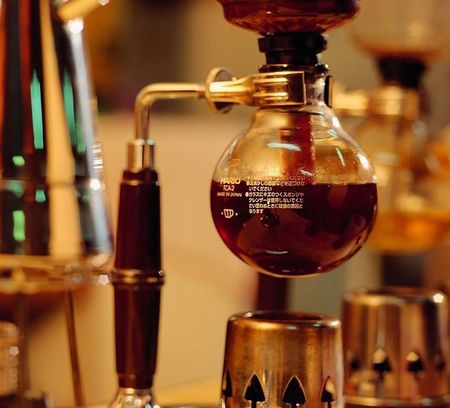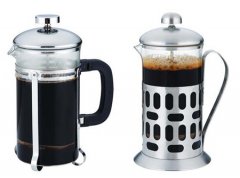Talk about making coffee: write to friends who don't know anything about coffee

First, why should coffee be "brewed"
If you know a little bit about coffee, you must know that coffee is roasted by raw beans at high temperature into the brown beans that we are all familiar with. So why can't coffee just like tea, pour these beans into a pot and boil them, or soak them for a while to make a cup of strong coffee?
We know that coffee is different from tea, it is a seed. Its density is much higher than that of tea, so it can't be eaten directly. It needs to be baked at high temperature, which is actually puffing. Because only the lignocellulosic structure of extruded coffee beans can be opened. Aromatic substances remain in crispy roasted (expanded) coffee beans. Coffee beans become larger and denser, and this process is necessary, otherwise we will not be able to get the taste of coffee (how coffee flavor is formed during roasting, which is too complex to go into detail here).
After the coffee is roasted, it needs to be crushed. The purpose of crushing is to increase the contact area between hot water and coffee powder. This will cause more aromatic substances to be extracted. We call this phenomenon increasing the extraction rate. Therefore, the whole coffee beans can not be completely extracted from the taste of coffee, so the coffee beans can not be boiled directly.
The next step is to use water to extract the taste of coffee from the coffee powder, and Jiner also has the color of coffee. So we have to drink a cup of coffee, coffee beans need to go through: puffing-crushing-extraction, can be obtained. So coffee needs to be "brewed".
Can coffee be "brewed"?
If we define "boiling" as heating water to 100 degrees and keeping it at that temperature for a long time, then coffee cannot be brewed. Because the source of flavor in coffee (aromatic oil) will be destroyed in the process of "boiling" at high temperature for a long time. Therefore, about 92 degrees Celsius is the ideal temperature for coffee extraction. So whether you are soaking (French pressure pot), or using a coffee machine, or siphon pot and other appliances, the water temperature of extracted coffee can not be higher than 96 degrees Celsius. So coffee can't be brewed in this sense.
In this way, in the production of filtered coffee, we can clearly see that the coffee should be brewed instead of being boiled like porridge. We use a variety of heat sources to heat only the water used to extract coffee, rather than directly boiling the mixture of boiling water and coffee powder (Turkish coffee is outside the scope of this discussion).
Third, why instant coffee doesn't need to be made
It can be clearly seen from the production process of instant coffee that raw coffee beans are extracted in specific containers after puffing and crushing (but instant coffee is called extraction in this process) into concentrate, filtered, and then dried in two forms, which is why instant coffee is divided into hot-dried instant powder and freeze-dried instant powder. At present, the vast majority of instant coffee in the domestic market is hot and dry instant powder. But in any case, the solid powder we get is exactly the solid soluble substance of coffee. The wood fiber (coffee grounds) of the crushed coffee beans has been filtered out after the preparation of the extract. So instant coffee doesn't need to be brewed. Because the solid soluble substance of coffee is easily dissolved in water.
But freshly ground coffee we need to filter out the coffee grounds after the coffee is extracted.
Fourth, freshly ground coffee can be "brewed" several times
Many friends often complain that coffee is more expensive than tea, because tea can be brewed repeatedly, but coffee can only be brewed once. There are also some friends who do not give up and extract the coffee many times. We say that this coffee can only be extracted once, but the coffee brewed after the first time can no longer be called coffee. Because there is a lot of caffeine in the brown water, or some scorched substances. We call this brown water Dirty Water. In fact, the standard method of drinking black tea in the West is only soaked once.
Important Notice :
前街咖啡 FrontStreet Coffee has moved to new addredd:
FrontStreet Coffee Address: 315,Donghua East Road,GuangZhou
Tel:020 38364473
- Prev

Mexican fragrant cocoa coffee
[English name]: Mexican fragrant cocoa coffee [English name]: Mexican Cocoa Coffee [production materials]: 1.5 ounces of espresso, 25 grams of Mexican cocoa powder, 6 ounces of chilled milk, right amount of milk foam, a little cocoa powder [production steps]: 1. Extract 1.5 ounces (45 ml) espresso with 14 grams of espresso powder and pour into a coffee cup. two。 Put chilled fresh milk
- Next

How do beginners choose coffee beans and utensils
Uncle Doushu proposed that coffee machines (utensils) serve coffee beans; coffee beans serve human taste, and the order of this relationship is irreversible. First of all, we need to know clearly what kind of coffee we like, and find suitable coffee beans and utensils according to this location. For example, if you don't like strong coffee, the espresso made by mocha pot, semi-automatic and fully automatic is
Related
- Beginners will see the "Coffee pull flower" guide!
- What is the difference between ice blog purified milk and ordinary milk coffee?
- Why is the Philippines the largest producer of crops in Liberia?
- For coffee extraction, should the fine powder be retained?
- How does extracted espresso fill pressed powder? How much strength does it take to press the powder?
- How to make jasmine cold extract coffee? Is the jasmine + latte good?
- Will this little toy really make the coffee taste better? How does Lily Drip affect coffee extraction?
- Will the action of slapping the filter cup also affect coffee extraction?
- What's the difference between powder-to-water ratio and powder-to-liquid ratio?
- What is the Ethiopian local species? What does it have to do with Heirloom native species?

